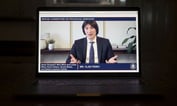 Mounting U.S.-China trade tensions and a shadow-banking imbroglio in India are keeping investors on edge Monday, just as emerging markets showed signs of recovering from seven months of turmoil.
Mounting U.S.-China trade tensions and a shadow-banking imbroglio in India are keeping investors on edge Monday, just as emerging markets showed signs of recovering from seven months of turmoil.
Fresh from a week in which a gauge of developing-nation currencies had its best five-day stint since February as both stocks and bonds advanced, markets are now having to cope with the imposition of levies on another $200 billion in Chinese goods and the fallout of missed payments by Mumbai-based IL&FS Group.
Later in the week, traders will focus on interest-rate decisions in Indonesia and the Philippines and the tightening race in Brazil’s election. All this when the Federal Reserve’s Sept. 25-26 meeting will likely provide clues as to how quickly policy makers will push ahead with the removal of stimulus.
“Pressure on EM will remain, as the U.S.-China trade tensions continue to simmer in the background,” said Khoon Goh, the head of research at Australia and New Zealand Banking Group Ltd. in Singapore. “U.S. tariffs on Chinese imports have the potential to increase U.S. inflation and how the Fed reacts to this will be important.”
With the yield on 10-year Treasuries holding above 3.05 percent and Brent crude having surpassed $80 a barrel, “current-account deficit currencies” will remain vulnerable, Goh said.
MSCI Inc.’s gauge of developing-nation currencies climbed 0.7 percent last week, putting it close to breaking above its 50-day moving average. Apart from two days in April, the last time the index crossed that level — in November — it heralded a four-month rally that drove it to a record high.
The index retreated on Monday, along with a measure for equities, which pared the rising streak in about seven months.
U.S.-China Tensions
China dashed prospects for a near-term resolution to the trade war with the U.S., warning President Donald Trump his threats of further tariffs are blocking any potential negotiations.
A 10 percent U.S. tariff on about $200 billion of Chinese goods takes effect from Monday, with the duties rising to 25 percent on Jan. 1 The risk of tariffs being raised to 25 percent from January, as announced by Washington, could still be negotiated away through concessions from Beijing over the next few months, according to NatWest Markets
India Contagion Fears
Investors are concerned that defaults by IL&FS, which has total debt of $12.6 billion — 61 percent in the form of loans from banks and other financial institutions — could spread to other shadow banks in Asia’s third-largest economy.
India’s benchmark equity index fell on Monday by the most since March as turmoil in non-bank finance companies deepened Indian authorities vowed to support financial markets by providing adequate liquidity to mutual funds and non-bank financial companies, Finance Minister Arun Jaitley said on Monday.
Indonesia, Philippines Set to Hike
Investors will monitor rate decisions by the Indonesian and Philippine central banks on Thursday to see if policy makers extend their hiking cycles.
Both countries run current-account deficits, making their currencies among the most vulnerable in Asia to the emerging-market sell-off Bank Indonesia has been the most hawkish Asian central bank this year, raising its policy rate by a total of 125 basis points since May.
It will probably lift it again this week. It’s also burned through about 11 percent of its foreign reserves since January to stem declines in the rupiah, which has lost more than 8 percent of its value against the dollar this year
The Philippines has struggled with inflation that accelerated to 6.4 percent year-on-year in August. Bangko Sentral ng Pilipinas has delivered 100 basis points of rate increases since May and more tightening looks likely after Governor Nestor Espenilla pledged “strong monetary action” at the Sept. 27 meeting.
The Czech Republic’s rate meeting on Wednesday is likely to result in an unprecedented third consecutive hike. Governor Jiri Rusnok joined an emerging consensus by saying he saw no reason to delay the move, meaning the focus after the meeting will be on any forward-looking comments
Fed Rate Path
With an interest-rate increase from the Federal Reserve already priced in, investors will be seeking clues about the pace of hikes next year and beyond.








 September 24, 2018 at 01:08 PM
September 24, 2018 at 01:08 PM












 Copyright © 2024 ALM Global, LLC. All Rights Reserved.
Copyright © 2024 ALM Global, LLC. All Rights Reserved.